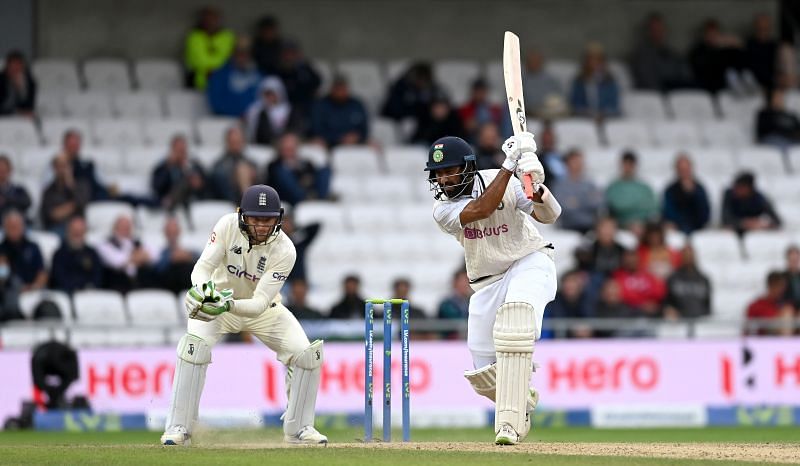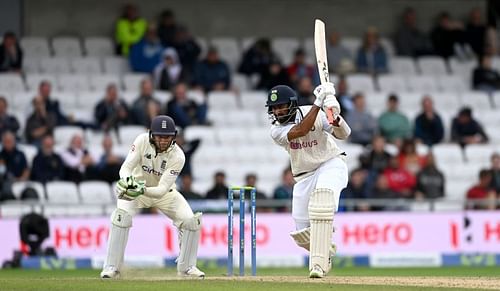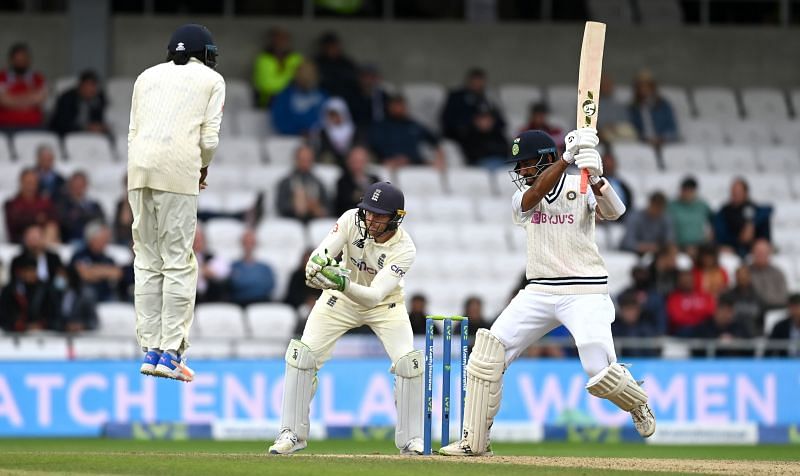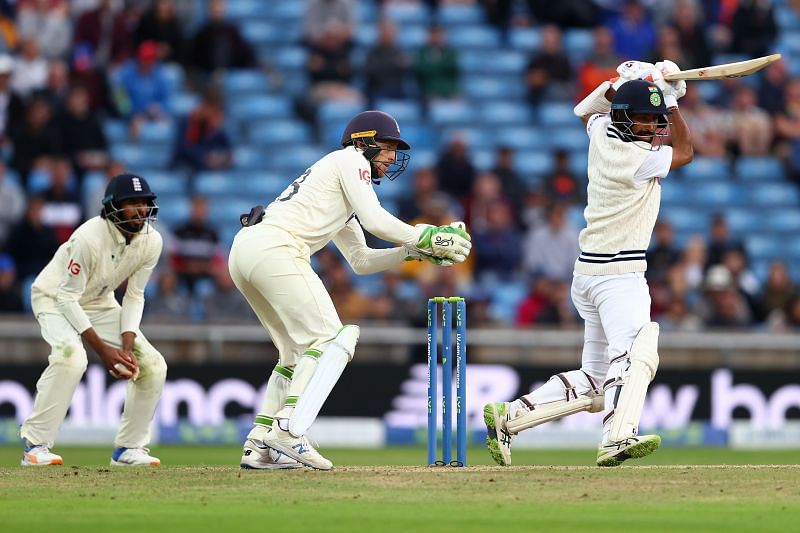
Cheteshwar Pujara rewinds the clock to produce vintage display

Back in October 2010, with a game against Australia tantalizingly poised, Cheteshwar Pujara, much to the collective moans and groans of the Indian faithful, strode out at No. 3. Incredibly, the Chennai Super Kings batter was making his Test debut in that fixture, and was doing so with illustrious names such as Rahul Dravid and Sachin Tendulkar waiting in the wings.
MS Dhoni, though, opted to send the debutant, hoping that the latter would be able to recreate the magic that had left the Indian domestic circuit spellbound. At first, it seemed like another instinctive decision by Dhoni – something that he had, by 2010, carved up quite a reputation for.
Yet, as each over passed by, it also showed the kind of trust the Indian team management had. In simpler words, it illustrated that Pujara, powered by a mountain of domestic runs, was the real deal and potentially the carrier of the Indian batting baton.
On that sultry afternoon in Bengaluru, Pujara handled the Australian spinners’ threat excellently. He used his feet, remained proactive throughout and cashed in on whatever scoring opportunities the visitors presented. Against the seamers, he followed a similar tack, with three of his six boundaries coming against pace.
Thus, over the course of that innings, Pujara, apart from showing that he was capable of handling the trials and tribulations of international cricket, portrayed that he was tight enough to thwart bowling obstacles, while also being astute enough to capitalize on loose deliveries.
Post that, the runs never really stopped flowing, meaning that the right-handed batter became a batting lynchpin under both Dhoni and Virat Kohli. More recently, though, the runs have dried up. And alarmingly, that has been preceded or followed by a general sense of tentativeness – tentativeness that wasn’t on display when he made his debut or during the highest crests in his Test career.
When he trundled out to the center at Headingley on Day 3, the stage seemed set for another display where calculation would triumph over creativity, where the dead bat would be Pujara’s best friend and where the emphasis would be on balls played rather than runs scored. India were staring at a 345-run arrears, for goodness’ sake.

Yet, in a refreshing turnaround, Pujara decided to traverse a different path. Rather than thinking about what he had been doing in the recent past, he decided to roll back the years and rely on attributes that had made him a household name in the first place.
As soon as he marked his guard in his inimitable manner, he quickly sought scoring opportunities. The likes of Craig Overton, James Anderson and Ollie Robinson were uncharacteristically friendly and offered Pujara a few deliveries on the pads.
Lately, the Indian batter has been content to defend those too. On Day 3 though, he used that as a springboard to launch his innings – an innings that saw him score at a strike rate of a 100 runs per 100 balls, until he reached 14. Even after that, he batted at a strike rate higher than Rohit Sharma.
While that can be taken with a pinch of salt, considering England bowled a lot more at Pujara’s stumps, it still highlighted that he didn’t just want to survive at Leeds. He also wanted to score runs.
Most tellingly, though, the elements that had been cornerstones of his success during the early and mid-2010s came gushing back almost instantly.
Cheteshwar Pujara batted with a lot of intent
Over the past couple of years, Pujara has completely put away the backfoot strokes into the off side. Instead, he has been willing to leave those deliveries alone and wait for balls on the pads. However, with oppositions also smart enough to set a leg-side field, run-scoring avenues swiftly evaporated for the Indian batter.
Thus, the back-foot punches and the cut strokes – shots that he deployed against the English pacers on Day 3 became vital. Not only did it allow Pujara to keep the scoreboard moving, but it also forced the bowlers to bowl closer to him – something that he was waiting for on a sluggish surface.

Interestingly, on the broadcast, this was an aspect that Ajay Jadeja had stressed upon. When talking about what he felt was necessary to be successful in SENA countries, he quickly quipped that the cut shot was imperative. From that perspective then, Pujara was wise to bring it back just when he needed it the most.
Additionally, the Indian batter was happy maneuvering short deliveries for runs. On one occasion, he used the ramp shot to fetch himself a boundary, whereas he also smashed a pull past square leg to bring up his fifty. Eerily enough, that was the exact shot Pujara had conjured to reach his maiden half-century at Bengaluru in 2010.
Apart from that, Pujara was also not averse to getting inside the line of the ball and working it into the leg-side. Though a few boundaries were a direct result of the poor lines England bowled at the outset, a few others were manufactured, with the different positioning helping him immensely.
The front-foot drives through the mid-off and the extra cover region were also a sight to behold, considering that hasn't been very ubiquitous lately.
When he started off his career, Pujara looked very comfortable on the on-side. Some even said that he resembled the great Rahul Dravid when playing those kinds of shots, especially the flick off his pads between mid-wicket and mid-on.
For some reason, though, Pujara decided to shelve it post that historic tour of Australia in 2018-19. Since then, he just wanted to just keep biding his time. But with time not being something a mere mortal has ever managed to control, he kept succumbing to it.
Overseas tours, where Pujara was expected to provide solidity, began turning pear-shaped far too often. While the right-handed batter still continued occupying the crease, the lack of runs meant that the Indians were never really out of the woods – something that could’ve happened at Leeds as well but something that Pujara ensured didn’t transpire.
Yet, in cricket, as happens frequently in top-level sport, numbers and especially the kind Pujara was producing (he was averaging 25.95 since the start of 2020 before the 3rd Test), began being scrutinized. And for good reason too.
At a position where teams ideally need batters to move the game forward and be proactive, he was becoming too reactive – so much so that he was also guilty of killing the side’s batting momentum at times. Basically, the newest incarnation of Pujara had become untenable on a lot of counts.
The Indian cricket team, meanwhile, thought they had been backing the Pujara that rocked up in Bengaluru in 2010, absorbed all of the pressure, walked in ahead of Dravid and Tendulkar and blunted an Australian attack on a tricky track.
The version of Pujara, post 2020 and before the second innings at Headingley, was a pale shadow of his former self. And when India openly backed this Pujara, billions lost patience and even clamored for his head.
Now, though, the batter seems to have rewound the clock (just in time, mind you) and has perhaps accorded himself a new lease of life.
The danger of him reverting to his post-2020 method still remains but Pujara has, apart from proving it to a billion eyes, proven to himself that the method that defined the early and middle phase of his career is perhaps what he needs to keep repeating regularly.
And if that happens, maybe he will be able to hush the doubters and the opposition, much like he did against Australia all those years ago!